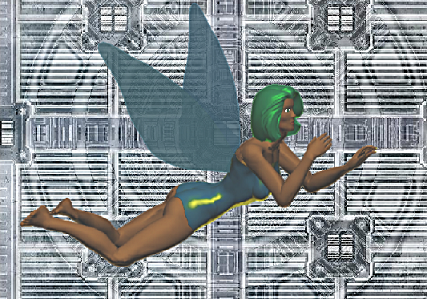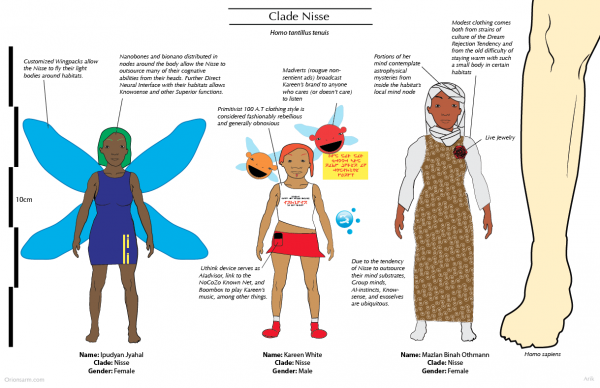BY LETTER
Nisse, Clade
In the past human baselines could, as a species, vary in height by as much as two metres. This was due to several medical conditions that usually came with complications that also shortened the lifespan and were weeded out of the nearbaseline genome in timely fashion. However as humanity spread to the planets and stars variance in the human form was found to be useful and the gengineers began creating new clades of man that were even taller, like the Goliaths, and smaller, like the Nisse.
History
The Nisse actually started out from a natural drift in their genepool. During the Interplanetary Age their forbearers settled on 77185 Cherryh, a small asteroid with limited volatiles. As their population grew the process of insular dwarfism (also known as island dwarfism) shifted their genepool to smaller sizes. Rather than fight this trend they chose to guide it and used their gengineering to keep ahead of the negative effects of reducing size.Spreading out from their home later in the Interplanetary Period these pre-Nisse found gainful employment as ships' crew (in microgravity they could do as much work as a larger crewman but they needed much less living space and life support) and were soon a common sight in the Solsys. Using their new wealth to buy the latest in superturing computers and nanotech they were able to improve the living conditions on their home while also slowly moving it outsystem during the Nanotech Window. These pre-Nisse had been watching the Inner System with great concern for many years and they could see bad times ahead. Outbreaks of goo and nanotech attacks, new clades of heteromorphic humans and provolved animals being subjected to fear and abuse, old political powers being overtaken by new polities, interstellar colonization and, most worrying of all, vague reports of transapient intelligences were giving them cause to believe something "bad" just had to happen. They were right of course but due to their foresight they were also well protected and when the Interplanetary Dark Age hit they just hunkered down behind their blue goo defences and waited it out. It was during this period of isolation that they would become the Nisse.
 Image from Steve Bowers | |
| Members of the subclade Homo tantillus tenuis often wear customised wingpacks; this increases their faerie-like appearance | |
Biology
Even before gengineering became possible nature-induced flaws in the human genome had produced humans as small as half a metre tall. These were created by a rare form of dwarfism called Primordial Dwarfism, a condition that results in a smaller, but proportionate, body size in all stages of life beginning from before birth. With advanced gengineering, nanotech and superturing AIs to guide them the soon to be Nisse could not only match this but better it. What they created was a beautifully proportionate human form in miniature, a clade of tweaks that were not only a mere 30 cm, on average, but also healthy and free of negative side effects.The "healthy and free of negative side effects" part was more easily said than done; the human form simply could not accommodate such a small size and not produce negative side effects but the Nisse took a staged and step-by-step approach to the task and were able to work through each problem as it came up. One big problem was procreation. If an adult Nisse is tiny then a baby Nisse is minuscule. Even something as simple as heat loss can threaten a newborn's life.To delay childbirth and give the foetus more time to grow, the Nisse use a range of alternative reproduction strategies. Another problem was keeping their intelligence level up. A proportionate human form means a proportionately sized human head and at only 30 cm high such proportionality produces a brain too small for baseline intelligence. However, as their size decreased with each generation the Nisse were able to counter this using various tricks; Some were the same tricks the provolvers of the African Gray Parrot used. (Bird brains are naturally more efficient from the need to keep mass low for flight.) They had also used some su genes. (If the Superiors could have superbright intelligence in normal sized brains why couldn't they have normal level intelligence in smaller brains?) Additionally the Nisse brain is not fully developed in all regions, to make room for other regions that have to be more developed. It is most developed in the prefrontal cortex, a region responsible for Executive Functions [1], while the functions in the underdeveloped regions are augmented through the use of compubones, produced by bionano that is now passed on to the child in its mother's milk. Finally the compubones, and its related DNI, allow the Nisse to outsource their higher brain functions to their habitats' computronium nodes; this gives them various superior abilities, like a superbright level Knowsense. Then, there are their physical abilities.
The Nisse are of course much weaker, physically, than larger bionts and can't lift heavy weights, in absolute terms. However in proportion to their size they are much stronger than larger bionts due to the effects of cubic geometry [2]. The Nisse are about 1/6 as tall as a baseline. They have at best only 3% his physical strength, but because their mass is so much more reduced they are far more agile. A Nisse could do chin-ups one handed with two fellow Nisse hanging on to his legs. Proportionate strength isn't the only thing that makes a Nisse so agile. Because of their small size their neural pathways are also far shorter, this gives a Nisse the reflexes of a cat.
Although later Nisse would take a different view, when the original Nisse began their gengineering their goal was not just to create a functional miniature of the human form but also to create a beautiful one as well. As such they followed the classical standards of body proportions. As a result their form was not what it would be if they had evolved to their small size. Their eyes for example, while not quite proportionate to their heads, were smaller than they should be for a being their size. At that time their eyes were just large enough to give them a child-like charm. This was a trade-off, the smaller eyes allowed for more room in their head for a larger brain but their resolution suffered. However with DNI linkage to their habitat's sensors they didn't suffer too much for it. Another trade-off could be found in their bone structure. At that earlier time their bones were thicker than they needed to be for the loads they were normally put under, however these thicker bones could house more computronium and made the Nisse more robust. These Nisse functioned well in high-acceleration spacecraft.
Current Era
The Nisse have spread far in the Terragen Sphere, they find it relatively easy to get passage on ships of all kinds. If a ship can carry even a single neb it can carry a small breeding group of Nisse. The Nisse adopt the memes of the polities they live in and get along well with other races because they are almost never seen as a threat. Interestingly enough, one race the Nisse get along with particularly well are the Goliaths. The two races share similar views on living in an off-sized world. The Nisse have also sub-claded several times to adapt to whatever world they settle on and are now a superclade in their own right. For example:Homo tantillus tenuis have less muscle mass, slender legs, arms, and torsos(and thusly weigh less for a given height) and have much larger eyes in proportion to their head compared to baselines. And while they are still relatively more agile and athletic than baselines, it is less extreme than predicted by uniform scaling rules. This sub-clade look very much like faeries and make great play on that fact, even to the point of wearing customized wingpacks as part of their every day attire.
Homo tantillus blefuscu are small, stocky humanoids, adapted to the heavy gravity and helium-rich atmosphere of their home planet.
Notes:
[1] Executive Function relates to abilities to differentiate among conflicting thoughts, determine good and bad, better and best, same and different, future consequences of current activities, working toward a defined goal, prediction of outcomes, expectation based on actions, and social "control" (the ability to suppress urges that, if not suppressed, could lead to socially-unacceptable outcomes). There is also an integral link between self-awareness (a person's personality) and the functions of the prefrontal cortex.[2] Take a shape, like a sphere, and double its diameter. Its width increases by a factor of 2, its cross section by a factor of 4 and it's volume by a factor of 8. Now do this to a man: a Goliath is twice as tall as a baseline but 4 times as strong because his strength is a function of the cross section of his muscle tissue. However he should also weigh 8 times as much. Of course in the real world scaling is not this simple: Instead, among similarly shaped creatures, you find scaling according to the principle of elastic similarity. An elastically similar strut or cantilever will experience the same relative deformation under the load of its own weight. This ensures a constant resistance to buckling (the primary mode of bone failure, as well as buckling about a joint due to overloading the muscles) under athletic activity. This form of scaling requires thickness to increase faster than length, but then mass also increases faster. The same thing happens with muscles so there's no question that a Goliath can lift greater weights than a baseline, but he can't do chin-ups. The opposite is true for scaling in the other direction.
Related Articles
Appears in Topics
Development Notes
Text by AI Vin
Initially published on 23 March 2008.
Initially published on 23 March 2008.







